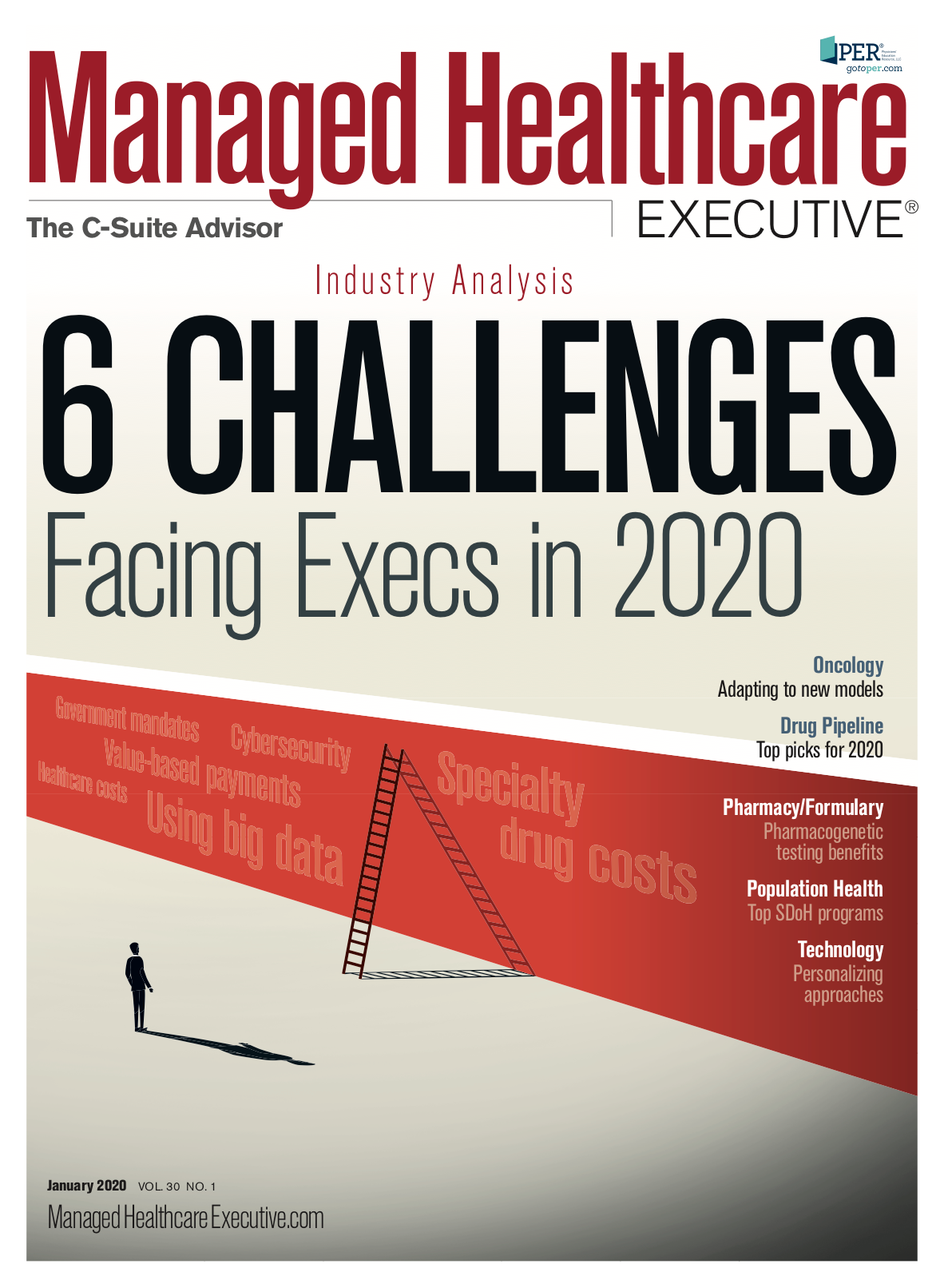Top Issues Facing Pharma in 2020
Novel drugs, value-based contracting, biosimilars, and regulatory activity addressing costs will be among the hot button issues in the coming year.

The year 2020 holds many exciting changes in the ever-evolving world of managed care. Experts say that organizations can expect to see the launch of new therapies and the payer-related nuances-a direct reflection of the continued push toward personalized medicine.
“We are living through an era of exponential change,” observes Ross Hoffman, MD, chief medical officer at Envolve Pharmacy Solutions.
These changes will impact several areas across a variety of therapeutic areas while driving formulary changes and new payment considerations.
Specialty Drugs and Drugs for Rare Diseases Abound
New specialty drugs emerging from the pipeline will enter the market at an accelerating pace. According to Melissa Duke, PharmD, executive director of population health pharmacy solutions at Banner Health in Phoenix, Arizona, this forthcoming trend will have a significant impact on the managed care industry while altering the patient experience.
"Payers who support these industries are experiencing unprecedented growth-especially with rare diseases and orphan drugs," Duke observes. "These new drugs for rare diseases are life extending and improve quality of life in patients who previously didn't have a therapy available to them.”
Related: 8 Policy Changes to Expect in 2020
More specifically, therapeutic categories with new products on the horizon include gene replacement therapy, gene editing, cell therapy, and cancer immunotherapy-significant industry disruptors that Hoffman says will only help enhance the industry-wide progression to more individualized therapy.
However, the benefits do not come risk free. Many of these drugs are first-in-class with never-before-seen mechanisms of action, unique drug development processes, and special supply chain considerations. And the novel breakthroughs often come at a steep price, with the cost of some of these drugs exceeding $1 million per dose.
Additionally, Sheila Arquette, RPh, executive director at the National Association of Specialty Pharmacy, points out that patients will continue to face challenges accessing specialty drugs, a direct consequence of health plans and payers continuing to limit access to participation in certain networks. Pharmacy carve-outs and channels, or carve-ins, only add to this problem.
The result leaves patients dealing with the fallout-many of whom find the degree of autonomy in selecting pharmacies increasingly more limited. Hoffman believes the price points associated with specialty therapies carry transformative potential while leaving some controversy surrounding unanswered questions regarding the long-term value of these novel drugs.
“We’re seeing accelerated FDA approvals of breakthrough status agents, with only partial evidence of long-term treatment efficacy or durability,” he notes.
Curative Therapies Potentially Disruptive Therapeutically and Financially
Duke cites Zolgensma-the drug that famously, or infamously-broke records as the world's most expensive drug at the cost of more than $2 million-as a game-changer. And its impact exceeds its hefty price tag.
While the drug’s high cost is disruptive in itself, the potential for curative therapy it offers enhances its impact in the healthcare world.
“Previously, kids who had spinal muscular atrophy didn’t live beyond 2 to 6 years old,” Duke says. “Now, they have a normal life expectancy."
The new year will also include the launch of several novel therapies for hemophilia, a condition which Hoffman says now holds the promise to cure a subset of the affected population. Like their predecessor Zolgensma, the curative potential of these drugs promises to transform the patient experience as well as the lives of their families. The emergence of such therapies could potentially disrupt industry providers associated with hemophilia support products and factor replacement therapies.
Despite having received FDA approval in early 2019, Novo Nordisk’s Esperoct (turoctocog alfa pegol, N8-GP) for the treatment of hemophilia A in children and adults will not make its market debut until 2020. Biomarin has its sights set on gaining approval for valoctogene roxaparvovec (BMN 270) for hemophilia in 2020.
Formulary and Payer Changes Create Hurdles as Well as Solutions
To help address the costs of higher-end drugs, such as Zolgensma and other gene therapies, organizations might want to consider cost modeling. Zolgensma manufacturer Novartis reportedly engaged in a payment plan with the hospital for the first recipient who received the drug in the summer of 2019-an arrangement Duke says is a new payment model. In such cases, the agreement is made between the hospital administering the drug and the manufacturer.
As for formulary changes, both Duke and Sheila Arquette, RPh, executive director of the National Association of Specialty Pharmacy, agree that biosimilars will receive the greatest focus, as their price point typically falls lower than the reference drug. Payers have an opportunity to negotiate a lower price point.
In fact, nearly 70% of specialty drugs currently in the pipeline share an association with an identified biomarker. Identifying a biomarker serves two important purposes: (1) it plays an important role in helping providers select and customize the most appropriate therapy for the patients-especially when combined with pharmacogenomics-and (2) it also offers manufacturers positive reassurance regarding the value of their products. The combination of these two features helps to ensure superior outcomes for patients, notes Arquette.
In an effort to contain costs, step therapy will also become more of a trend. According to Duke, this phenomenon will follow suit behind 2019 initiatives by CMS that encourage step therapy. The organization expanded step therapy to include Medicare Part B. The rule requires that Part D sponsors expand their formularies to include all drugs listed as protected classes of psychoactive drugs such as anticonvulsants, antidepressants, antipsychotics, antineoplastics, antiretrovirals, and immunosuppressants for transplant rejection treatment. The rule offers Part D sponsors the option of requiring prior authorization and step therapy requirements for new patients.
There will also be an uptick in enhanced efforts to implement value-based contracting-a feature Arquette says will reach an unprecedented level of interest.
“While managing the cost of specialty products has focused mainly on drug prices in the past, value-based contracting seeks to link the price of a drug to clinical or economic performance,” she says.
These demands illustrate the benefit of specialty pharmacies, which make significant contributions to the patient care paradigm through the provision of what Arquette defines as “high-touch patient care” and coordination of care with other healthcare providers, resulting in enhanced healthcare outcomes.
Despite the apparent benefits, Arquette cautions that implementing value-based contracting is no small undertaking. Instead, this type of contracting demands tremendous efforts on behalf of healthcare providers in the form of collaboration and coordination among healthcare providers while requiring organizations to assume some degree of financial risk.
Drug Pricing Reform, Improving Adherence May Help Ease Economic Burden
Legislative and regulatory activity aimed at addressing the high cost of prescription drugs, including specialty drugs, is underway. The federal government is currently mulling over policies that would directly reduce drug costs at the point of sale-regardless of whether the transaction occurs at the pharmacy counter or during the provision of care.
In the world of specialty pharmacy, Arquette says a form of payment overhaul known as "pharmacy direct and indirect remuneration (DIR) reform” would bring these patients immediate financial relief, and senior citizens would enjoy copay reductions on expensive therapies for which no generic alternatives exist.
"Pharmacy DIR reform ensures all pharmacy price concessions are used by a plan to reduce a Medicare patient's upfront cost," Arquette explains. "This reform also would support services needed to improve patient outcomes through drug management."
Another critical element in easing the financial burden is addressing medication adherence. Optimizing patient adherence amplifies the patient outcomes and utilization of the healthcare system by optimizing therapeutic value, reducing waste, and improving cost containment. Implementing quantity limits (30-day fill) can be helpful, but Arquette says partial fills can also prove beneficial when ascertaining a patient's tolerance for a medication. Additional cost management strategies include prior authorization and utilization management edits, such as step therapy.
Looking to 2020 and Beyond
In addition to new drugs that will help mitigate chronic conditions such as hemophilia A, hemophilia B, and beta thalassemia, patients who have sickle cell anemia also have new hope.
The approval of Endari (L-glutamine) for sickle cell anemia in 2017 marked the first approval of a new drug for sickle cell anemia in nearly 20 years. In 2020 there will be two new drugs for the condition on the market-both of which gained approval in late 2019. The FDA approved Advakveo (crizanlizumab) in November 2019, and Oxbryta (voxelotor) gained accelerated approval several days later.
Cancer will continue to remain a hot therapeutic area experiencing tremendous growth, according to Hoffman, who says more than 400 immunotherapies are in development.
While generic options for specialty medications have been minimal, the future may paint a different picture.
“Substantial investments in the development of generic specialty medications are being made, and it is expected within the next five years that alternatives to significant specialty drugs will be available soon,” Arquette says.
With numerous biosimilars in the pipeline, she projects 2020 may see a few blockbusters. Given the high cost of the biological reference drug after which these drugs are patterned to emulate in effect, the prospect of more biosimilars on the horizon could have a tremendous impact on patient access as well as healthcare spending.
Frieda Wiley, PharmD, RPh, is a contract writer and consultant pharmacist.
Newsletter
Get the latest industry news, event updates, and more from Managed healthcare Executive.
